Market Intelligence Tools for GTM and Sales Teams in 2025
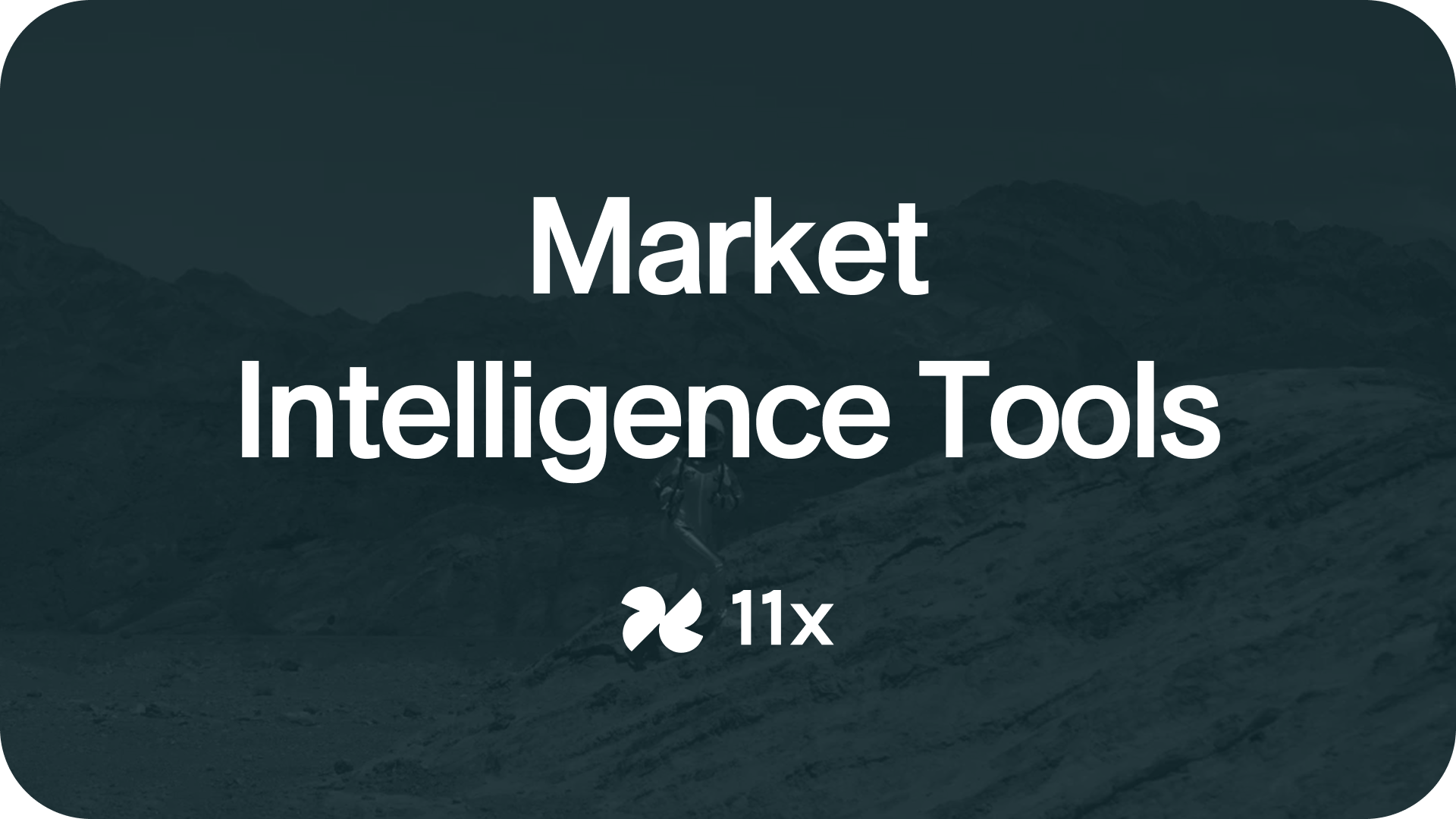
Market intelligence software has become a central pillar of modern SaaS GTM strategy. With buyer journeys shifting toward digital-first research, crowded markets, and shrinking budgets, sales and marketing teams can’t rely on guesswork. They need visibility to focus efforts where there are high-value returns. At 11x, we’ve seen firsthand how the right intelligence stack transforms GTM execution. It gives teams the clarity to act on real signals instead of assumptions.
Market intelligence tools provide that visibility. They help teams identify in-market buyers, track competitors, and uncover opportunities in real time. This article breaks down the major categories of tools, compares leading options, and explains how to select the right fit for your GTM stack.
Market intelligence tools: the three core types
Market intelligence isn’t one-size-fits-all. Different tools solve different problems depending on where your GTM team is focused. Broadly, they fall into three categories that build on one another:
- Data collection & unification tools
These platforms bring fragmented information into a single place. They enrich CRM records, pull in firmographic and technographic details, and give teams a cleaner, more accurate view of prospects. Think of tools like Clearbit or 6sense. They don’t just add data. They unify it so sales and marketing can act on the same signals. - Prospect & intent intelligence tools
Once the data foundation is solid, the next challenge is figuring out who’s actually ready to buy. Prospect and intent platforms surface in-market accounts, highlight the right decision-makers, and signal when engagement should happen. ZoomInfo, Cognism, and LinkedIn Sales Navigator fall into this camp. They help SDRs and marketers prioritize high-fit leads instead of chasing cold ones. - Competitive & market intelligence tools
Finally, GTM teams need to understand the external environment: what competitors are doing, where markets are shifting, and which trends matter. Tools like Crayon, Similarweb, Owler, Statista, and G2 provide that outside-in view, from competitor product launches to digital ad spend benchmarks to peer reviews. This helps companies position more effectively and respond quickly to rival moves.
Together, these three layers make up the backbone of modern market intelligence stacks.
Comparison table: Market intelligence tools
Before diving deeper into individual platforms, here’s a side-by-side view of leading market intelligence tools. This snapshot highlights categories, key features, starting prices, and the best-fit scenarios, allowing you to quickly compare options at a glance.
Clearbit
- Category: Data collection & unification
- Key Features: CRM enrichment, scoring, intent reveal
- Pricing: Free tier; Paid ~$150–$275/mo
- Best Fit: SMBs needing CRM upkeep and lead enrichment
6sense
- Category: Data collection & unification
- Key Features: Predictive AI, buying intent orchestration
- Pricing: From ~$25,000/year
- Best Fit: Enterprise ABM teams seeking high fidelity intelligence
ZoomInfo
- Category: Prospect & intent intelligence
- Key Features: Contact database, intent signals, technographics
- Pricing: From ~$15,000–$39,000+/year
- Best Fit: High-volume outbound teams needing deep data
Cognism
- Category: Prospect & intent intelligence
- Key Features: Mobile-verified data, Bombora intent, GDPR-compliance
- Pricing: ~$1,500–$25,000/year
- Best Fit: Global teams needing compliant contact data
LinkedIn Sales Navigator
- Category: Prospect & intent intelligence
- Key Features: Advanced search, InMail, TeamLink
- Pricing: $99.99/user/mo
- Best Fit: Relationship-based, ABM sales teams
Crayon
- Category: Competitive & market intelligence
- Key Features: Real-time competitor tracking, battlecards
- Pricing: ~$8,000/year+
- Best Fit: Product/marketing teams needing live competitor insights
Similarweb
- Category: Competitive & market intelligence
- Key Features: Website traffic, digital share, advertising insights
- Pricing: $199–$499/mo
- Best Fit: Marketing teams benchmarking digital performance
Owler
- Category: Competitive & market intelligence
- Key Features: Competitor news alerts, funding, revenue estimates
- Pricing: Free; Pro $39/mo
- Best Fit: SMBs tracking competitors affordably
Statista
- Category: Market research & analyst intel
- Key Features: Market reports, infographics, statistics
- Pricing: Custom packages (~$6,500+)
- Best Fit: Analysts and strategists needing market context
G2
- Category: Market research & analyst intel
- Key Features: Peer reviews, software comparisons, market grids
- Pricing: Free; enterprise packages available
- Best Fit: GTM teams evaluating software decisions
Tool deep-dives
The right tool depends on your goals, team size, and GTM motion. To help you see how each category fits, we’ve broken down the leading platforms with context on where they add the most value.
Data collection & unification
Strong intelligence starts with clean, structured data. These tools enrich and unify records so sales, marketing, and RevOps all operate from the same trusted foundation.
1. Clearbit
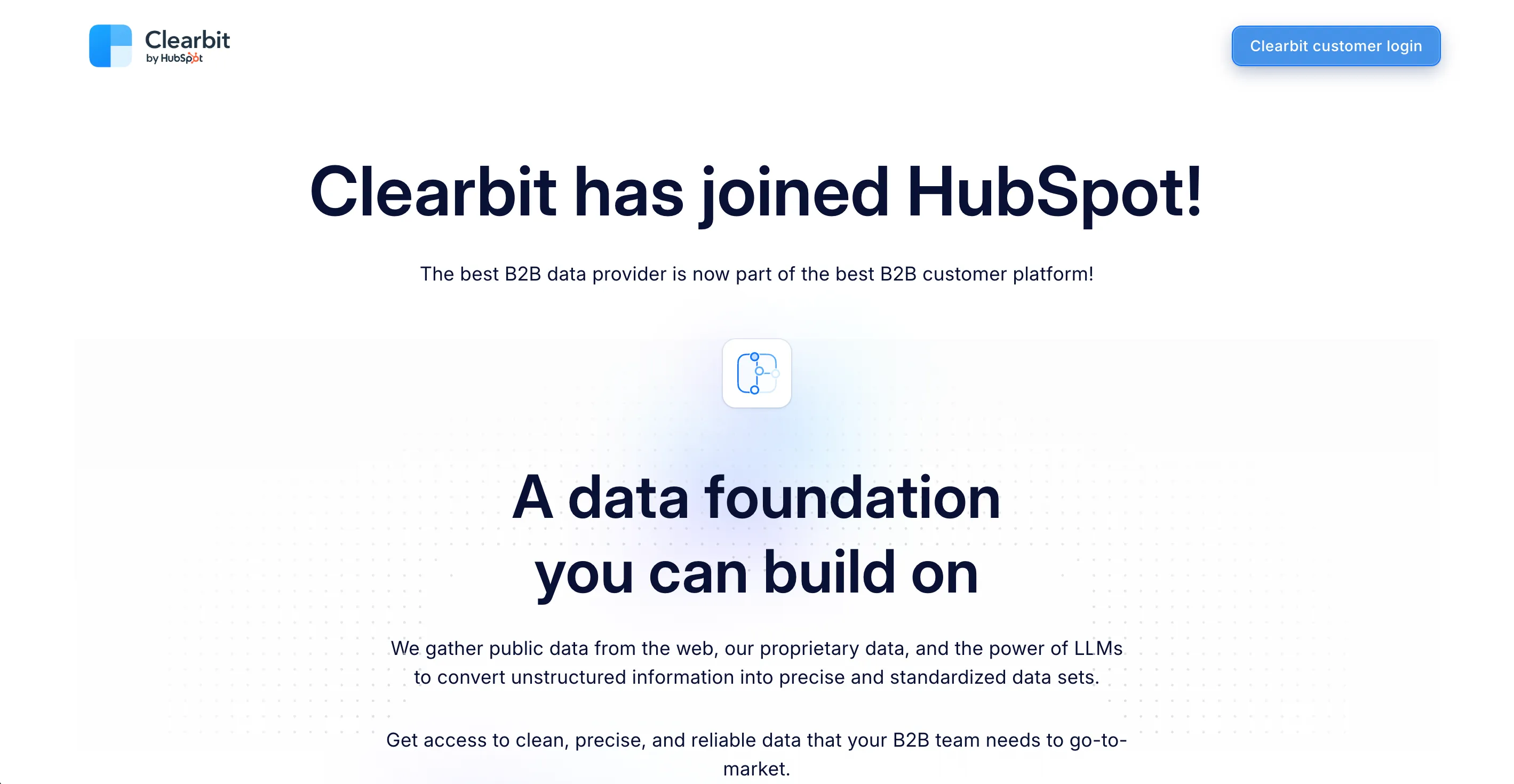
Clearbit centralizes company and contact intelligence so your CRM and MAP stay complete and current. It enriches inbound leads in real time, auto-filling firmographics, technographics, and engagement signals. SDRs can qualify faster and marketers can segment with confidence.
Teams use Clearbit to standardize records, score fit, reveal visiting companies, and personalize campaigns and marketing efforts without heavy ops work. It’s a strong fit for SMBs and growth-stage companies stepping up from spreadsheets to structured data flows. It also works for anyone who needs reliable enrichment without managing a complex data pipeline.
Limitations: Clearbit isn’t a full-blown ABM or intent orchestration platform. It won’t replace a large, sales-driven contact database for high-volume outbound. Regional depth can vary depending on your ICP, and success depends on good CRM hygiene.
Pricing is approachable with a free tier and paid plans in the low hundreds per month. This is a pragmatic first layer for GTM data quality.
2. 6sense
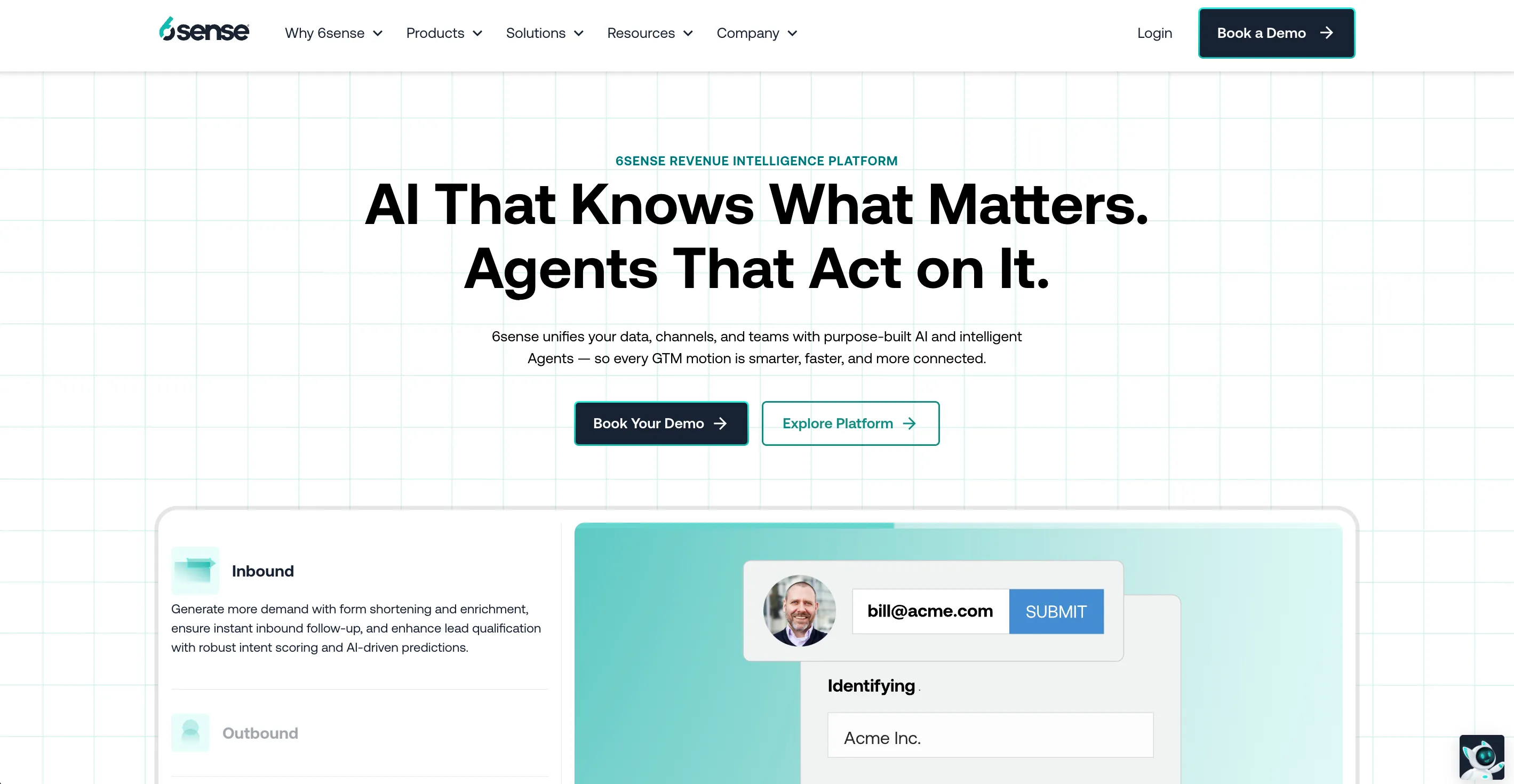
6sense applies predictive AI to illuminate the “dark funnel”. It models high-level buying intent across countless signals and scoring which companies are most likely to purchase. Enterprise ABM teams lean on it to coordinate ads, sequences, and sales plays around intent surges. This prioritizes budget and outreach where lift is highest. It’s best for mid-market and enterprise orgs with longer cycles, multiple stakeholders, and the appetite to orchestrate campaigns at scale.
Limitations: you’ll need clean first-party data, clear ICP definitions, and cross-functional change management to unlock value; otherwise, models underperform and adoption lags. Implementation can be heavier than enrichment tools, and the total cost rises with audiences, channels, and add-ons.
Contracts typically start around ~$25,000/year, so the ROI case hinges on pipeline influence and win-rate improvements. When well-implemented, 6sense gives leaders credible visibility into unseen buyer activity.This helps revenue teams focus where impact compounds.
Prospect & intent intelligence
3. ZoomInfo
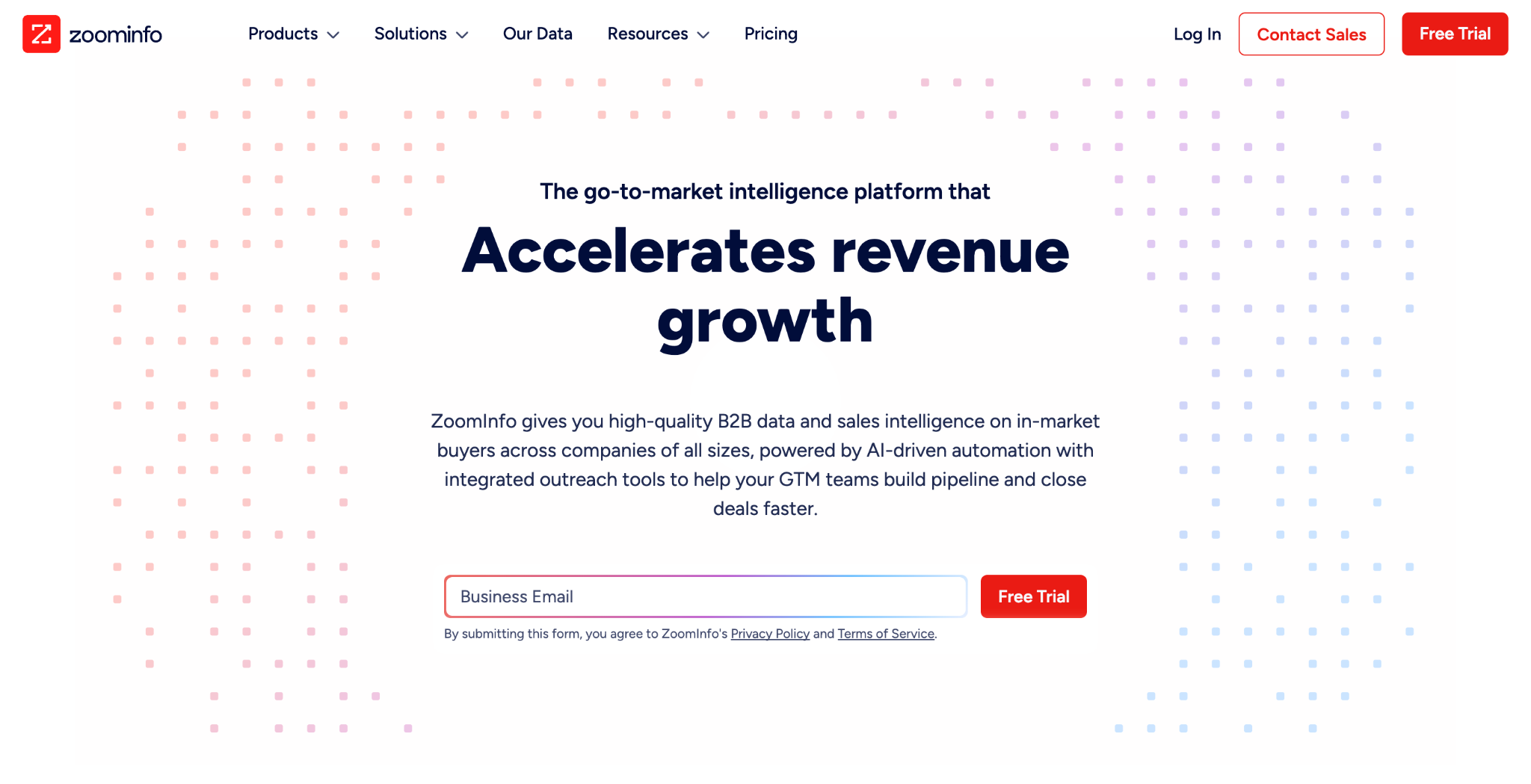
ZoomInfo combines a large B2B company/contact database with technographics and intent signals. Itgives outbound teams the depth they need to build lists, plan territories, and time outreach. SDR managers value direct dials, organizational charts, and topic-level intent to prioritize accounts that are actively researching. It’s a strong fit for high-volume outbound motions and larger sales organizations that need broad, deep coverage and robust data services.
Limitations: contracts can be pricey with tiers, credits, and add-ons; expect budgeting and governance to keep usage efficient. Data quality and coverage can vary by region and segment—global teams may still supplement for non-U.S. markets. ZoomInfo isn’t a substitute for ABM orchestration or competitive intelligence on its own. It’s best paired with tools that activate signals across channels.
With thoughtful enablement and QA processes, it’s a proven enterprise-grade backbone for prospecting at scale. Often starting around ~$15,000–$39,000+/year.
4. Cognism
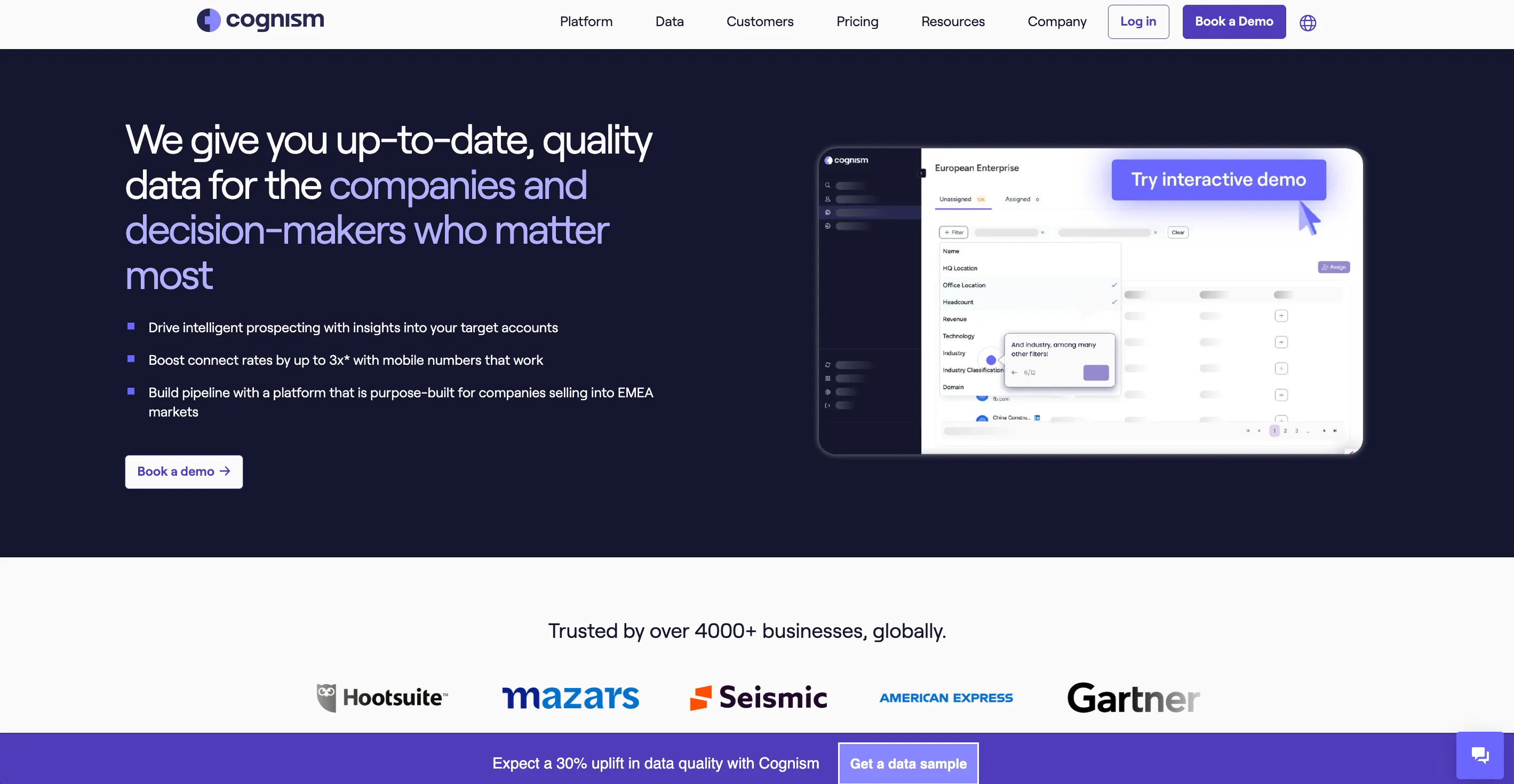
Cognism helps global teams enrich customer data while staying fully GDPR compliant. It focuses on accurate, compliant prospect data—particularly mobile-verified numbers—plus Bombora-powered intent data to help reps reach the right decision-makers at the right time. Global teams like it for GDPR-forward processes and strong EMEA coverage, using it to improve connect rates and focus outbound on in-market accounts. It’s a fit for privacy-conscious organizations, international go-to-market motions, and teams that need verified mobile data to drive call-led outreach.
Limitations: Like any data provider, coverage varies by region and niche. You’ll want to test against your ICP. To get full value, start with a clear onboarding plan. Define your list strategy, set up sequencing, and make sure CRM enrichment is working properly. Just as important, align on how intent triggers will be handed off to sales.
Pricing starts in the low thousands annually and scales with users and data volume. When governed well, Cognism reduces wasted dials, aligns outreach to real interest, and fills a gap where U.S.-centric databases can fall short.
5. LinkedIn Sales Navigator
.webp)
Sales Navigator turns LinkedIn’s professional graph into a relationship-selling engine. Reps sales reps use advanced search, alerts, and TeamLink to map committees. Saved alerts notify them when prospects change roles or accounts show new activity. TeamLink opens warm introductions through shared connections. And with InMail, they can reach decision-makers directly and engage with relevant context.
It’s ideal for ABM motions, strategic accounts, and any team that values warm paths into decision-makers over brute-force volume. Best fit spans SMB to enterprise, where social media and credibility matter, e.g., complex sales, partnerships, or executive-led outreach.
Limitations: Sales Navigator isn’t a contact data provider, bulk exports are limited, and you won’t get verified emails/phones at scale. Analytics are lighter than dedicated intelligence platforms, and usage caps (e.g., InMail) shape cadence. It pairs well with an enrichment or data tool to operationalize lists inside your CRM.
At ~$99.99/user/month for Core (with higher tiers available), its ROI comes from higher response rates, better timing, and tighter alignment to real relationships.
Competitive & market intelligence
6. Crayon
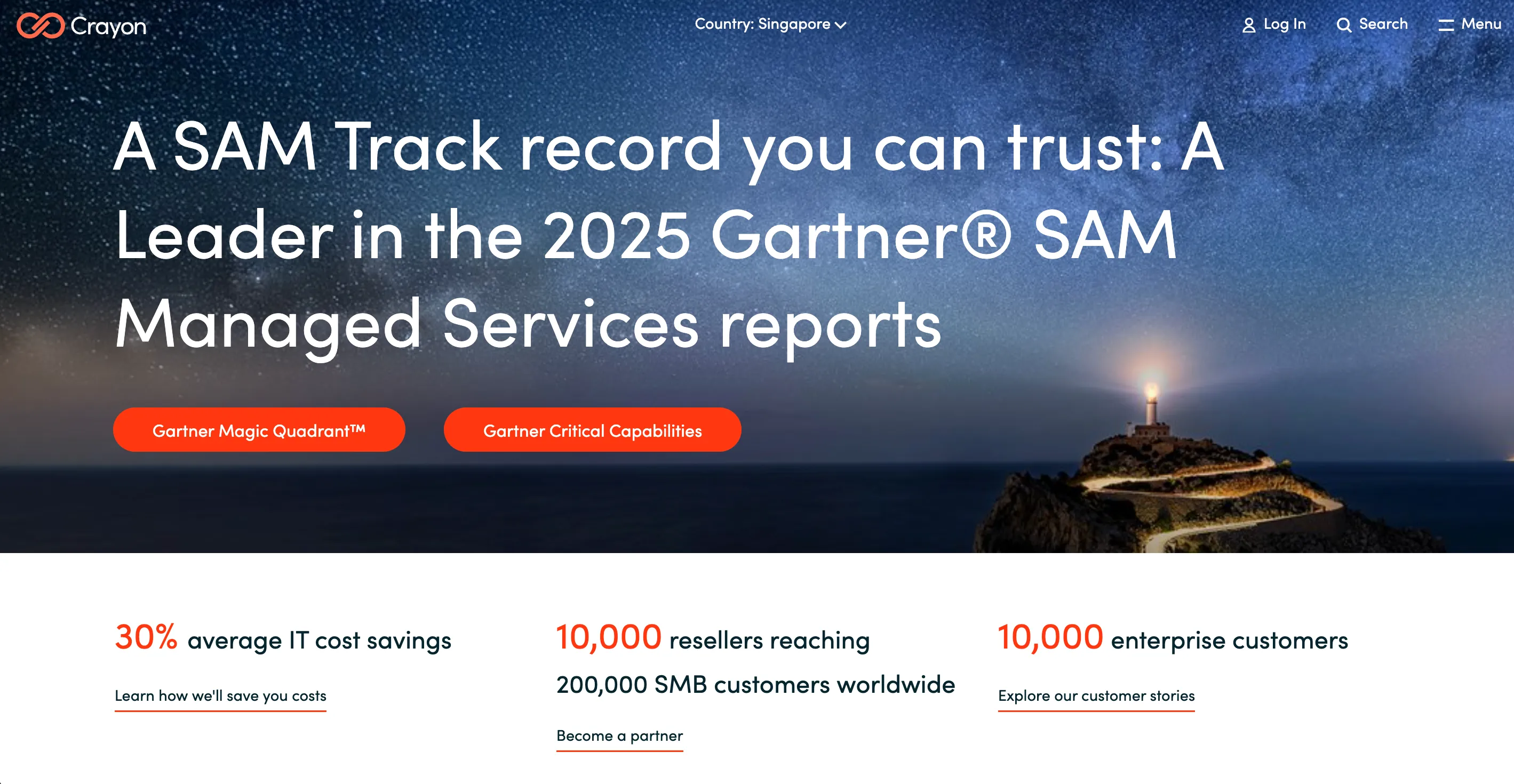
Crayon’s product marketing and sales enablement teams rely on battlecards. It’s built for teams that regularly face head-to-head comparisons and need a near real-time pulse on rival positioning. Product marketers use it to track launches and messaging shifts; enablement teams use battlecards to arm reps with counterpoints and proof. The platform also has curated dashboards that provide a competitive advantage in head-to-head deals.
Limitations: Like any monitoring solution, raw signal volume can be noisy. You’ll want an owner to curate, tag, and push the most relevant insights into CRM/Slack so intel reaches the field. Depth at the product-feature level may require supplemental research, and success hinges on sales adoption of battlecards.
Pricing typically starts around ~$8,000/year. Done right, Crayon turns competitor activity from a reactive scramble into real-time insights and updates.
7. Similarweb
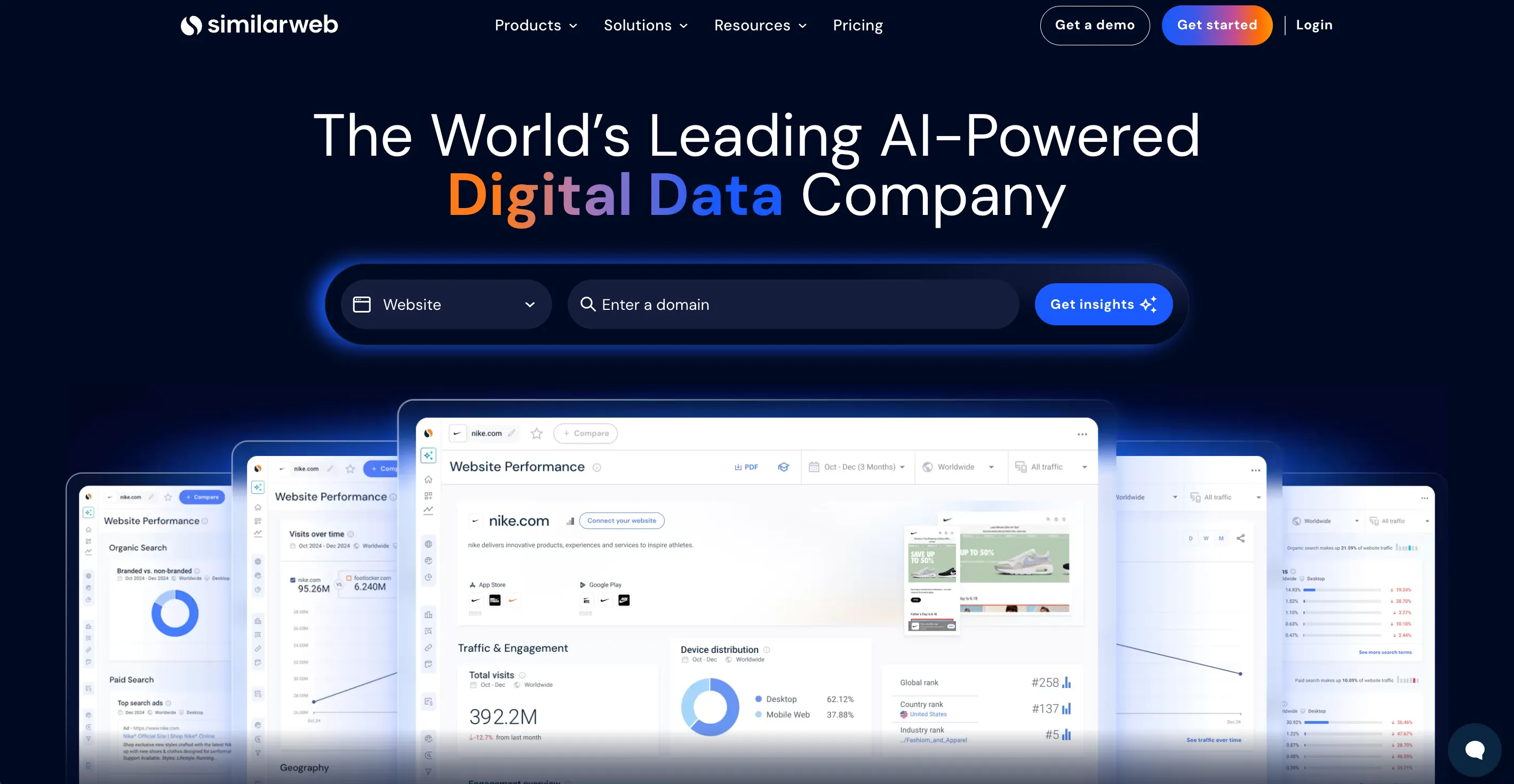
Similarweb provides outside-in digital intelligence, so teams can optimize their benchmark performance, SEO signals, and track digital market trends. Marketers use it to see how competitors acquire traffic, which keywords or partners move the needle, and where to reallocate budget. Product and strategy teams use trendlines to validate markets. It’s a great fit for leaders who want an independent view of the digital battlefield to guide channel mix and executive reporting.
Limitations: data is modeled/estimated from panels and partnerships, so smaller sites or micro-segments may show variance; historical depth and exports live behind higher tiers. It won’t replace first-party analytics or ABM intent, but it complements them with market-level context.
Entry plans are monthly, with enterprise options for deeper datasets and API access. Used alongside your own data, Similarweb sharpens decisions on where (and why) to spend.
8. Owler
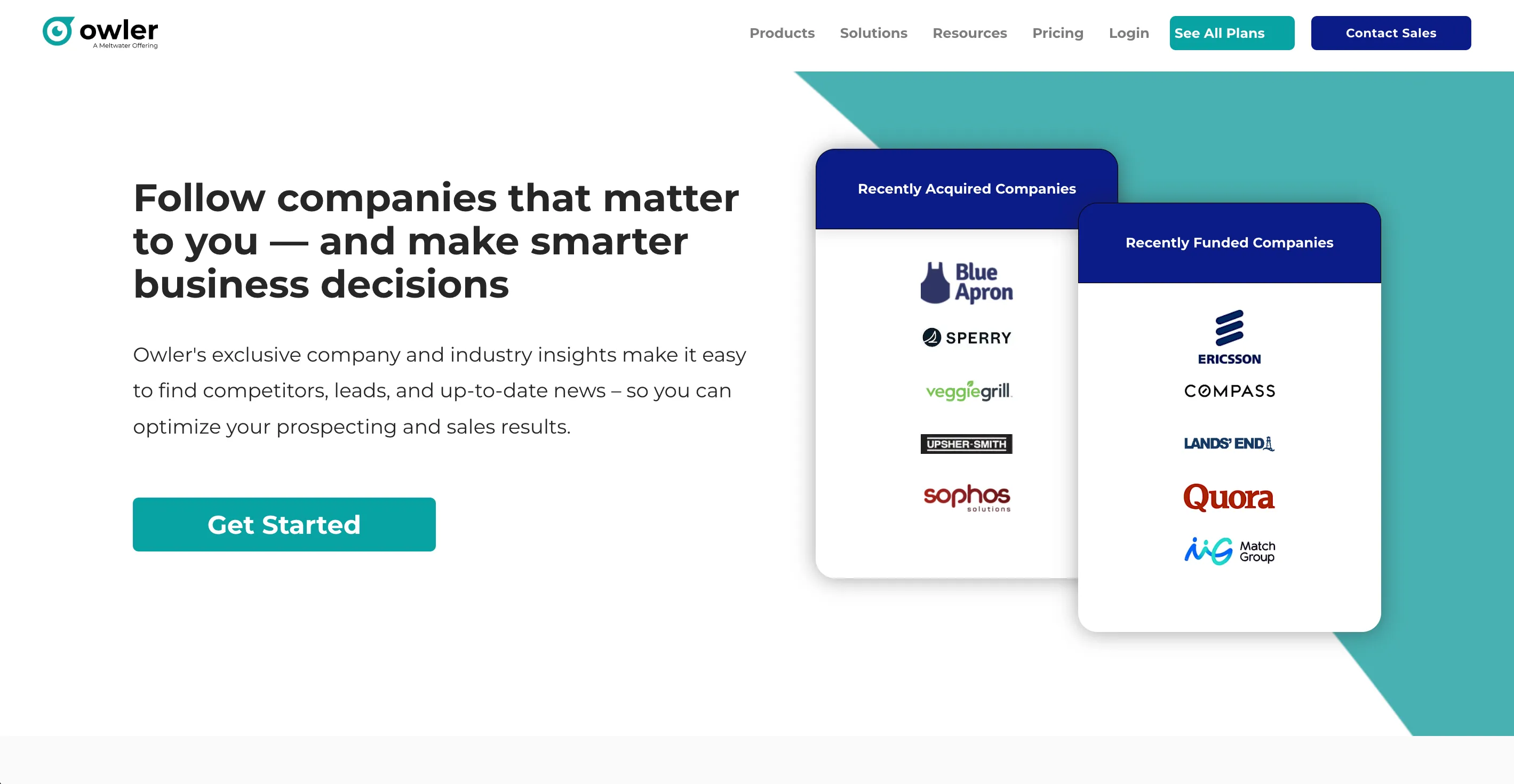
Owler delivers lightweight, crowd-informed competitive tracking, so you can keep tabs on a landscape without a big research budget. Teams use it for daily awareness across a watchlist of competitors, partners, and prospects. This feeds quick context into sales prep and exec briefings. It’s best for SMBs and early-stage companies to formalize competitive monitoring, or as a supplement to heavier CI stacks.
Limitations: estimates can vary in accuracy, depth is limited versus analyst platforms, and insights skew toward public signals and newsworthy events. It’s not intended for deep product/feature analysis or sophisticated enablement on its own.
The upside is speed, simplicity, and price (free tier, Pro at $39/month) that make adoption easy across go-to-market teams. As a low-lift layer, Owler systematizes “who did what” awareness so you’re rarely surprised by a press release or funding round.
Market research & analyst intel
9. Statista
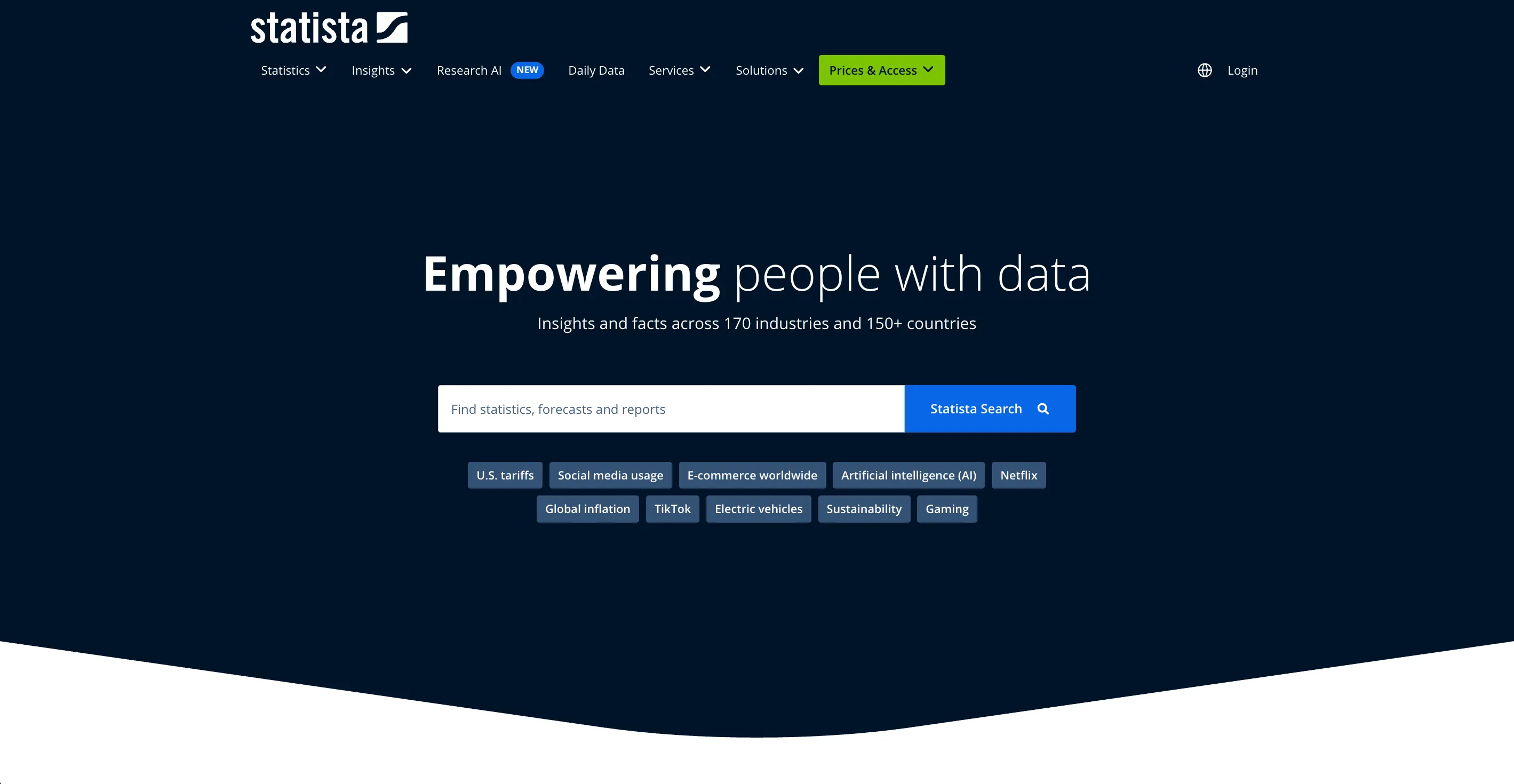
Statistia is used regularly by teams to forecast, make their strategic decision, and size TAM/SAM/SOM. Strategy, finance, and marketing leaders use it for TAM/SAM/SOM scaffolding, trend visuals for board materials, and quick fact-checks across 170+ industries. It’s best for organizations that regularly package insights for executives, investors, or content, and want a single hub of vetted references and visuals.
Limitations: depth and recency depend on source quality; niche or fast-moving segments may require triangulation with primary research. Licensing and usage rights matter if you republish charts.The platform won’t replace bespoke market studies when you need unique, ground-truth data.
Packages often start around ~$6,500/year. As a complement to tactical tools, Statista brings macro-level clarity that sharpens positioning, strengthens narratives, and accelerates decision-making with ready-to-use visuals.
10. G2
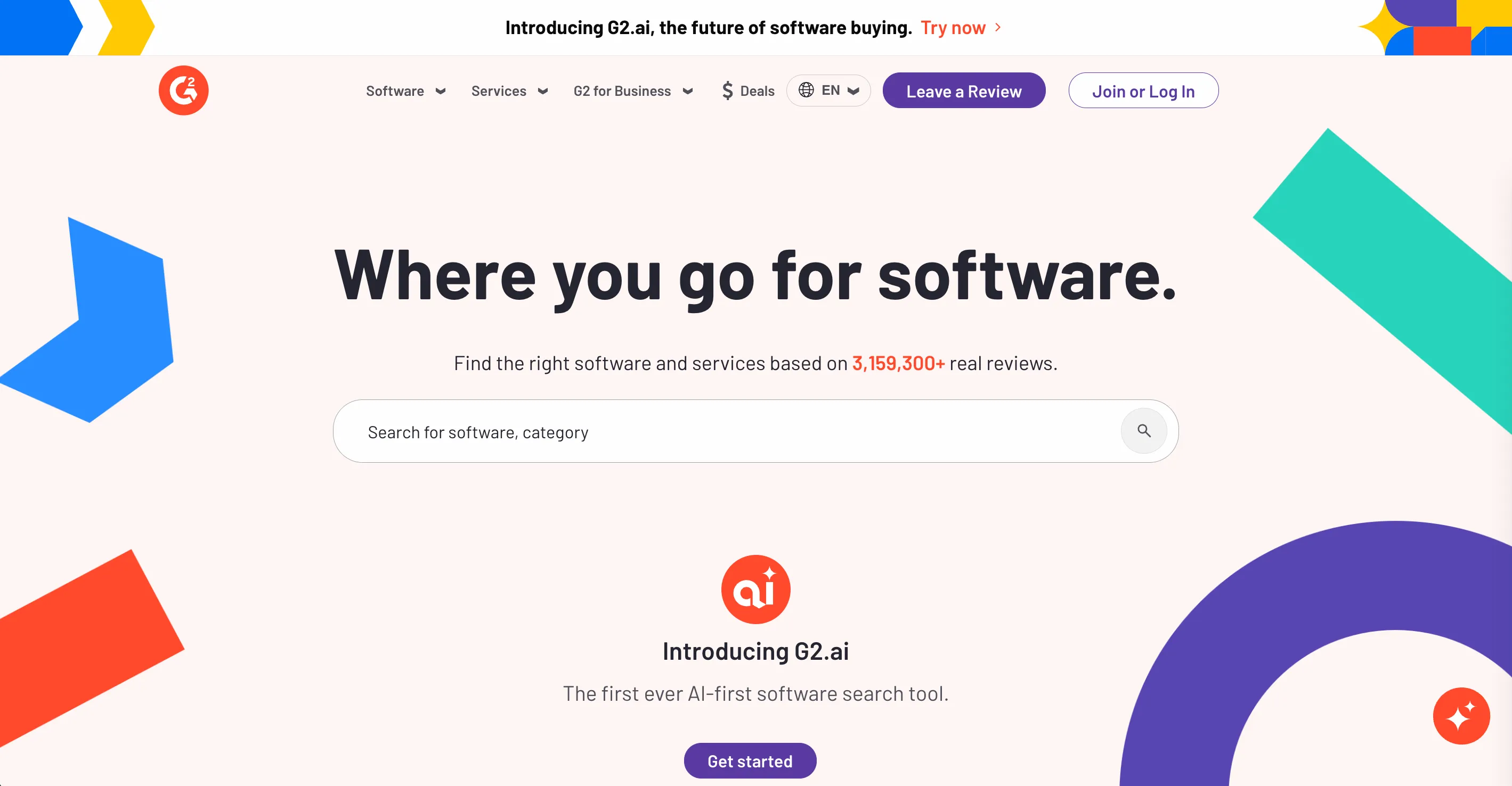
G2 is the peer-review backbone for software buying, category grids, side-by-side comparisons, pros/cons from real users, and momentum signals that shape vendor perception. GTM teams use it to shortlist tools, benchmark competitors, and mine language customers use to describe value and gaps. Marketers leverage badges and category placement as social proof in campaigns and on-site. It’s valuable for both SMBs and enterprises evaluating stacks or tracking category shifts.
Limitations: review quality varies; vendor incentives can introduce bias; and insights are strongest within software categories (not broader market dynamics). Advanced analytics, intent, and buyer activity typically live in enterprise packages. G2 won’t replace product testing or security reviews, but it reduces evaluation time and improves confidence by anchoring decisions to large samples of user experience.
Free access covers basics; paid plans offer deeper analytics and programs for vendors to activate their presence.
How to choose the right market intelligence tool
The best market intelligence tool isn’t necessarily the one with the longest feature list. It's the one that your team will actually use to make better GTM decisions every day. Too many companies invest in platforms that sit idle after six months because they don’t fit workflows or integrate with core systems. To avoid shelfware, weigh these factors before committing:
- Business goals first – Start with clarity on what you’re trying to achieve: net-new logo acquisition, expansion in current accounts, or competitive positioning. The right tool should directly support that priority.
- Coverage & accuracy – Evaluate whether the platform provides the global reach, compliance, and predictive signals your GTM motion requires. Enterprise ABM programs may need high-fidelity intent modeling, while smaller teams may only need reliable enrichment. It may vary depending on the sales cycle and motion you run—longer cycles benefit more from predictive intent data.
- End-to-end integration – Look for platforms that plug seamlessly into your GTM stack: CRM, MAP, analytics, ad platforms, and even call recording tools. Without full connectivity, you’ll be left piecing together partial insights.
- Attribution and reporting depth – Modern tools should go beyond “who clicked what” and help explain which touchpoints moved deals forward. Lift analysis, attribution modeling, and pipeline influence reporting are critical for proving ROI for real-time updates.
- AI-powered insights – Instead of dumping raw data, the best solutions surface recommendations: which accounts to prioritize, which channels are underperforming, and what competitive moves deserve attention. These AI-driven insights reduce analyst overhead and accelerates decision-making, while also looking at industry trends.
- Customizable dashboards & accessibility – Your SDRs, marketers, and execs should all be able to pull the views they need without waiting days for an analyst. Natural language queries and easy-to-use dashboards make adoption stick.
- Cross-functional workflows and alerts – Intelligence isn’t valuable if it sits in a dashboard no one checks. Strong tools push insights into Slack, email, or CRM in real time, making sure that GTM teams act when the window of opportunity opens.
- Privacy & compliance – For global teams, compliance with GDPR, CCPA, and regional data laws isn’t optional. Make sure the provider’s data sourcing and enrichment practices align with your standards.
- Scalability – Consider whether the tool can grow with you. A small team might start with Clearbit + LinkedIn, but an enterprise may require a full suite like ZoomInfo + 6sense + Crayon to cover data enrichment, intent, and competitive tracking at scale for your tech stack.
Bottom line: choose a tool (or stack of tools) that maps directly to your GTM strategy, integrates seamlessly with your systems, and drives action, not just reporting. Integration ensures sales, marketing, and RevOps all get full functionality from the same intelligence signals.
Final word
Market intelligence is a GTM multiplier, aligning with your company’s initiatives. The right stack gives the sales process and marketing visibility into where to focus, which competitors to beat, and how to time outreach. There’s no single “best” tool. Instead, the winning approach is a mix: enrichment for high-quality data accuracy, prospect intelligence for pipeline, and competitive intel for positioning. By aligning your choice with sales outreach, compliance needs, and budget, you’ll build a market intelligence stack that scales with your growth.
At 11x, we help GTM teams go beyond tools, pairing market insights with AI-powered automation tools to execute customer success. Our platform can streamline actionable insights with artificial intelligence that converts intent into meetings and revenue. If you’re building a smarter, more scalable GTM motion, schedule a demo today or get started with 11x to see how execution can keep pace with intelligence and the right playbooks.
Frequently Asked Questions
Market intelligence gives a broad view of competitors, industries, and trends, while sales intelligence focuses more narrowly on accounts and contacts. Both are complementary: market intel shapes positioning, while sales intel drives the pipeline.
Budgets vary widely, from free or less than $200/month SMB-friendly platforms to enterprise contracts exceeding $50,000/year. The right investment depends on team size, GTM complexity, and the revenue impact you expect.
Yes, but in a lighter form. SMBs may rely on enrichment tools (like Clearbit) or competitive monitoring (like Owler) rather than full-scale intent platforms. Even small teams benefit from cleaner data and faster insights.
Most leading tools connect directly with CRMs like Salesforce and HubSpot, plus MAPs like Marketo or HubSpot Marketing Hub. Integration ensures sales, marketing, and ops all work from the same intelligence signals.
Buying the most feature-rich tool without considering adoption. A platform only drives ROI if sales and marketing teams actually use it in daily workflows. Prioritize usability, integration, and actionable outputs over bells and whistles.



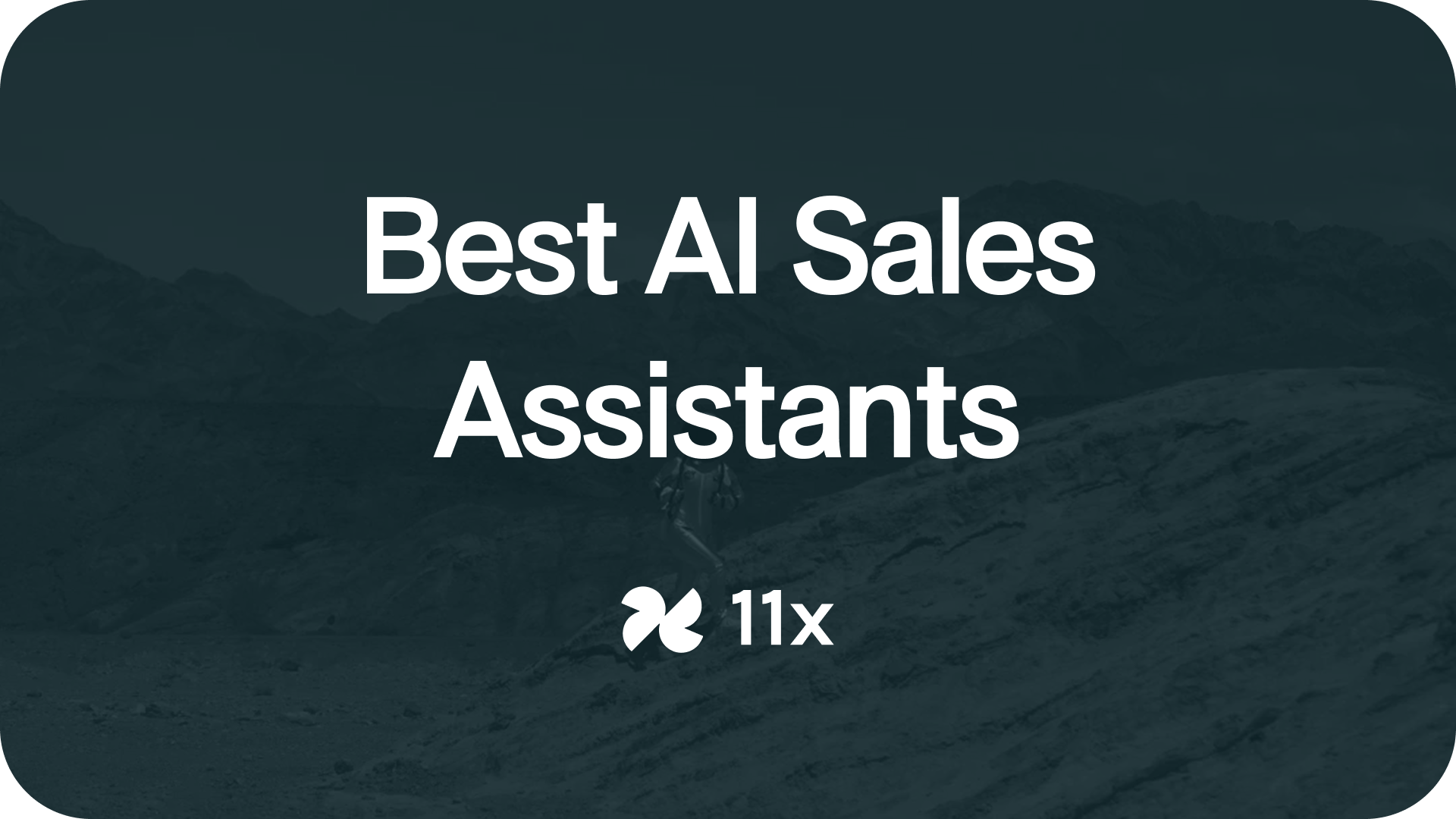
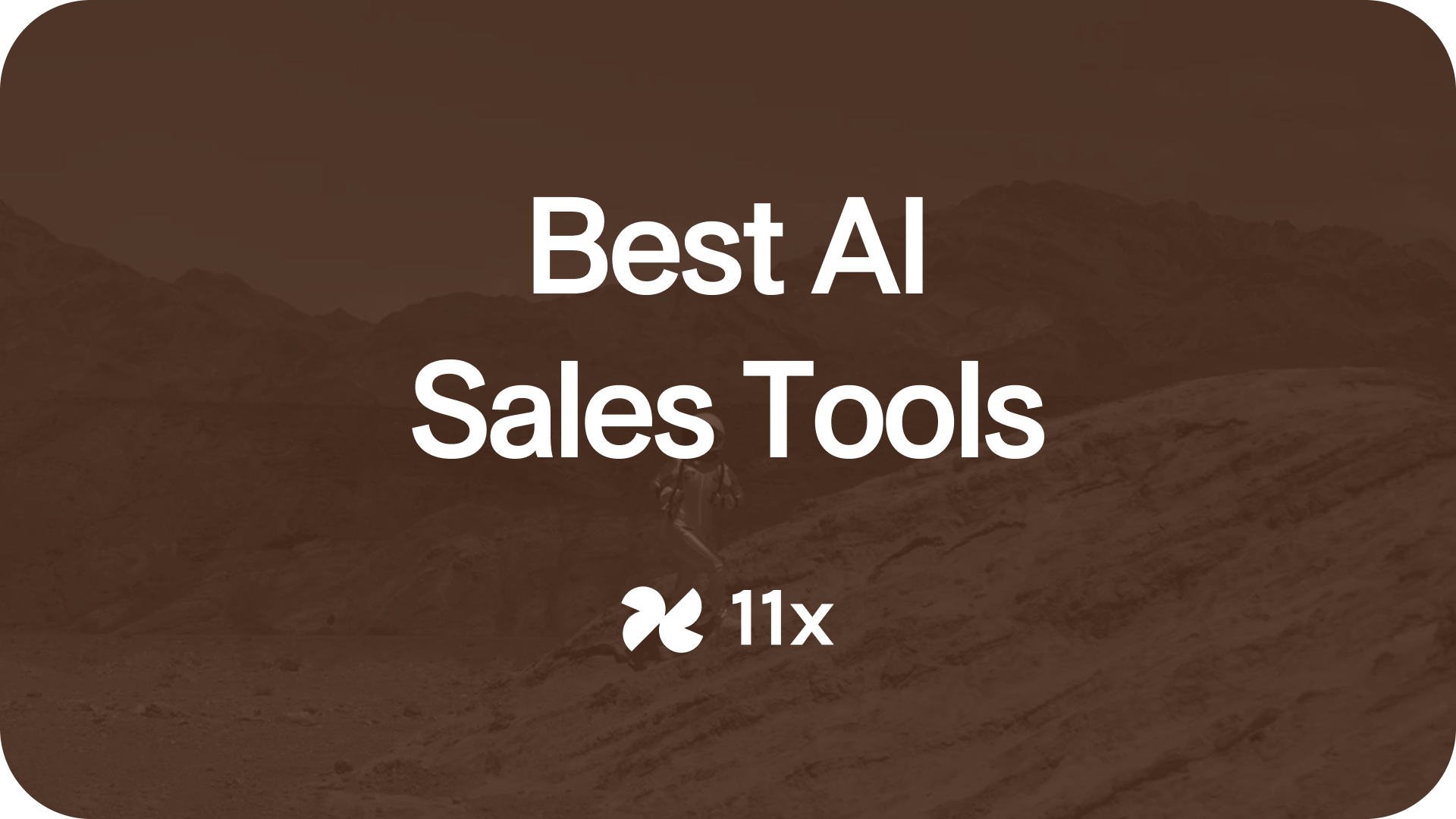
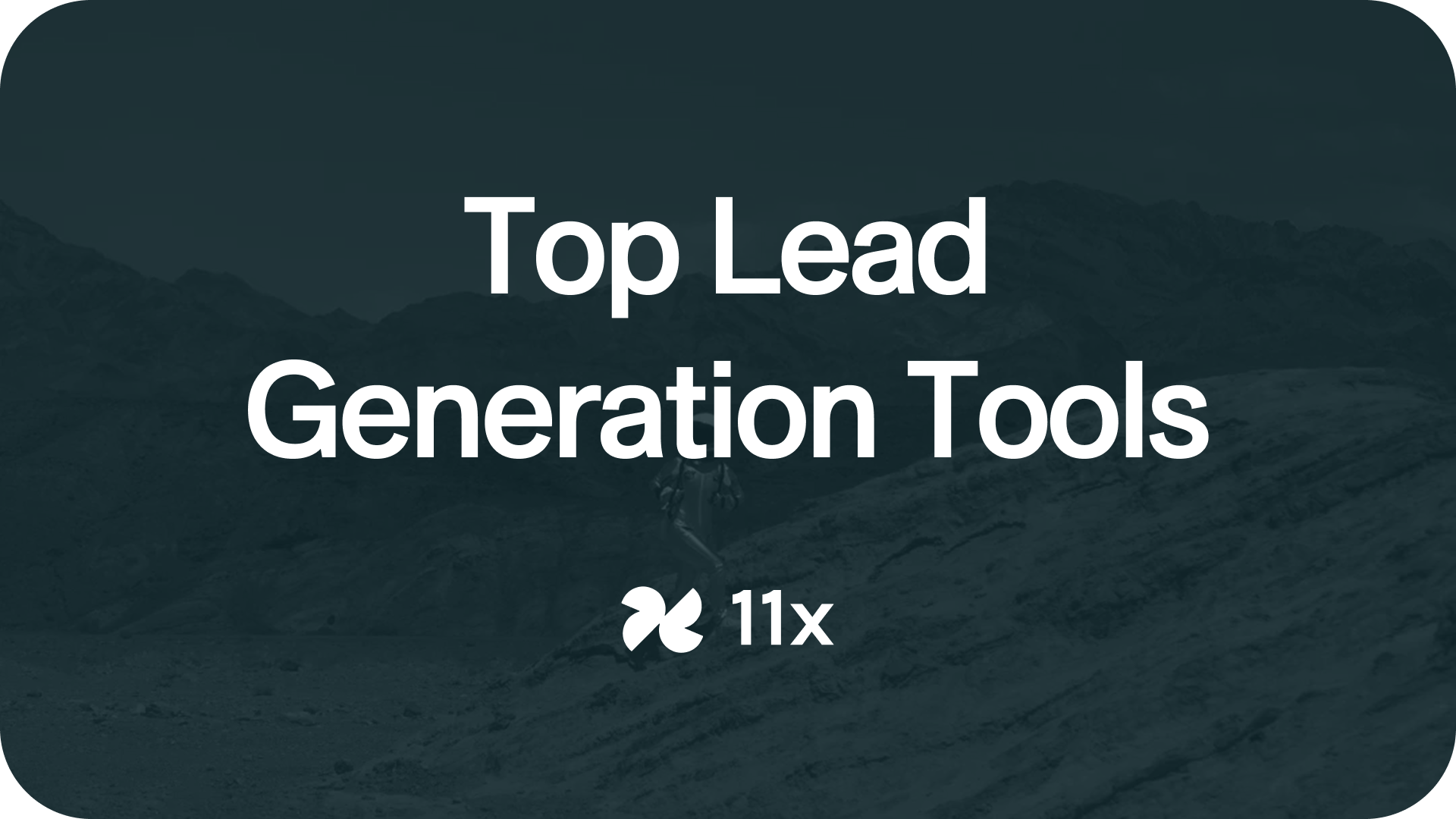
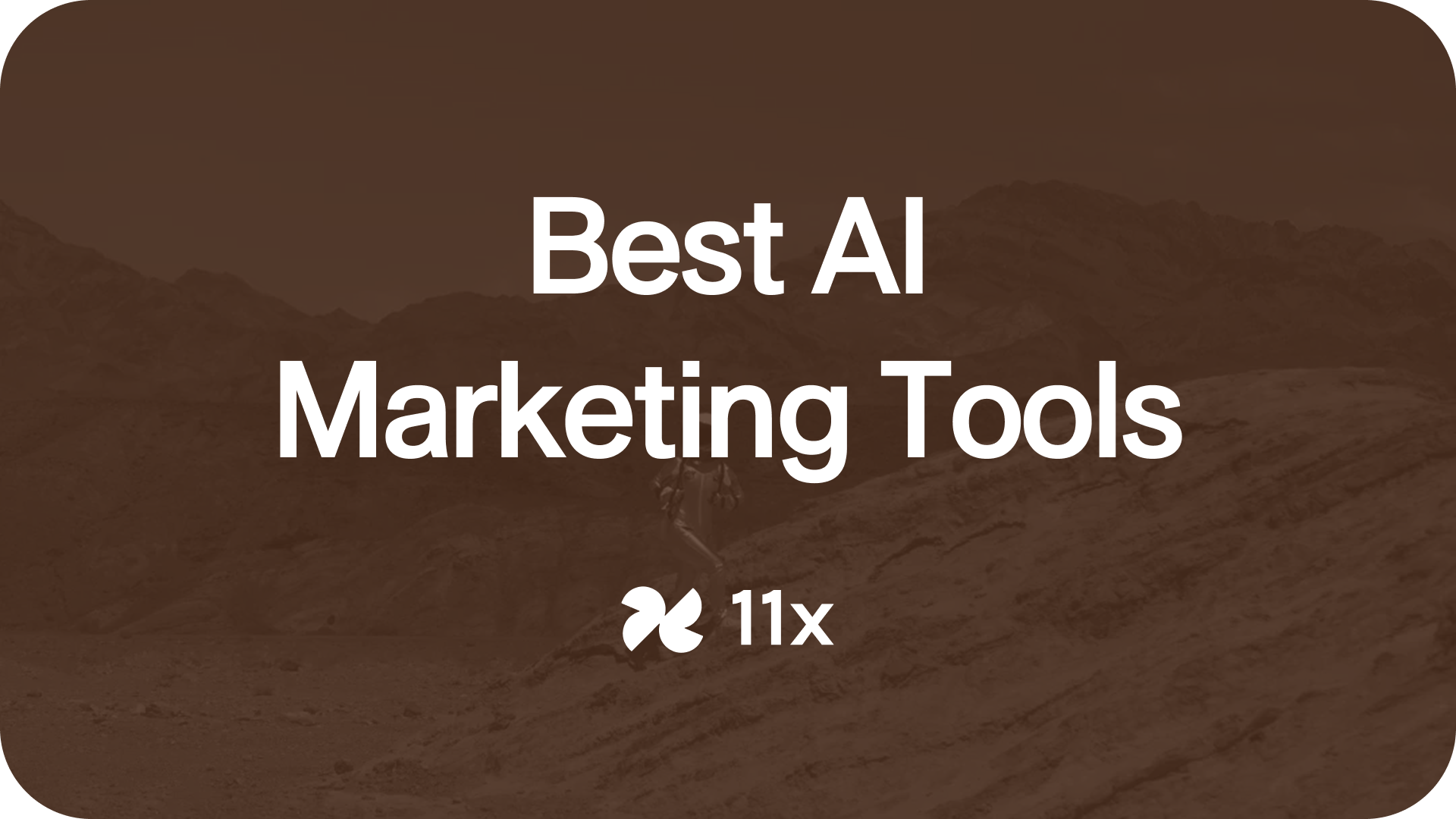
.png)